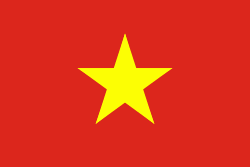Quang Ngai province (Tỉnh Quảng Ngãi)
The ancient Sa Huỳnh culture inhabited what is now Quảng Ngãi. Remains of it were found in Sa Huỳnh, Đức Phổ District. Within Champa, the region that is now Quảng Ngãi was less significant than Quảng Nam province and Vijaya. There are only a few Cham remains in the province. The area became part of Vietnam along with Vijaya (Bình Định province) in 1471. In the early 19th century the Long Wall of Quảng Ngãi was constructed in the province. It improved security among the Vietnamese and H're people and facilitated trade. The province had become a center for religious activity, in particular with the construction of a mountain-top monastery, the Thien An Mountain Pagoda in 1695. The mountain was designated by the ruler Nguyễn Phúc Chu and became a religious pilgrimage site.
Quảng Ngãi province was one of the first provinces in central Vietnam (together with Quảng Trị) to organize self-defense units in March 1945. The Ba Tơ Guerrilla Unit mobilized tens of thousands of peasants. It was known as a Việt Cộng stronghold during the Vietnam War and was the site of the purported Bình Hòa massacre and the My Lai Massacre. The province produced famous war literature on both sides of the conflict including the wartime diary of Viet Cong medic Đặng Thùy Trâm was written here, and from the US perspective, the setting of Tim O'Brien's The Things They Carried.
After reunification, the province was designated as the center of a planned oil industry notably the Dung Quất Refinery alongside special economic zones for the development of heavy and light industries.
Map - Quang Ngai province (Tỉnh Quảng Ngãi)
Map
Country - Vietnam
 |
 |
| Flag of Vietnam | |
Vietnam was inhabited by the Paleolithic age, with states established in the first millennium BC on the Red River Delta in modern-day northern Vietnam. The Han dynasty annexed Northern and Central Vietnam under Chinese rule from 111 BC, until the first dynasty emerged in 939. Successive monarchical dynasties absorbed Chinese influences through Confucianism and Buddhism, and expanded southward to the Mekong Delta, conquering Champa. The Nguyễn—the last imperial dynasty—surrendered to France in 1883. Following the August Revolution, the nationalist Viet Minh under the leadership of communist revolutionary Ho Chi Minh proclaimed independence from France in 1945.
Currency / Language
| ISO | Currency | Symbol | Significant figures |
|---|---|---|---|
| VND | Vietnamese đồng | ₫ | 0 |
| ISO | Language |
|---|---|
| KM | Central Khmer language |
| ZH | Chinese language |
| EN | English language |
| FR | French language |
| VI | Vietnamese language |















